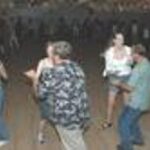Dance improvisation is movement that is not choreographed ahead of time. It may be structured, guided or free. Improvisation can be used to stimulate ideas for choreography, to help students learn new ways of moving their bodies or to get a great, creative workout.
Not many dance studios offer improvisation “classes”, but you may be able to find some through college dance departments, a modern dance company or in larger cities. Occasionally you can find freestyle dance jams and contact improv gatherings locally. Searing the internet can usually put you in touch with any communities in your area.
If you are an instructor looking for more structured improvisation exercises, or a choreographer looking for creative stimulation, here are some exercises to incorporate into an improv session.
Use lines, curves and shapes to guide movement. Try to make straight line shapes with your body, using a mirror to begin if needed. Then try to make curved lines with your body. Curve your spine, your extremities, your entire body. Next, make shapes by relating one body part to another. What shape, appears when your knee and shoulder relate? Your toe and stomach?
You can also change the time between changing shapes and the type of movement – slow and fluid from shape to shape or quick, staccato pulsing.
Another way to guide a dance improvisation with the idea of shape is to work with movement through shapes or objects. If you have real objects (furniture, boxes, props) you can use them to work with, but you can also simply imagine them in your space. Move within the boundaries of the object, move around it, move through it.
The next dance improvisation exercise is to change the qualities of a phrase of movement. Begin by choreographing a series of steps. Then change the qualities and dynamics of the movement. Change the duration of individual movements, taking a long time to execute them or a very short time. Then try doing the entire phrase fast or slow. Which movements work better at different speeds? Other qualities to play with are tension, energy, direction and levels (high and low).
Directed or structured improvisation can be done using sets, props and costumes. Use an these to stimulate movement, and then try to do the same movements without the props. How does your movement change? You can also do a structured improv with sound – either music or sounds made with your body. Snap, click, clap, brush, stamp – how can you make different sounds with your body? Expanding on the sound idea, you can use words to stimulate movement. Adjectives work well as you can try to make movement with that quality. And finally, you can do a structured improvisation using a story or characters. This would be similar to charades, though it is helpful to try not to limit yourself to obvious interpretations.
Improvisation is a great way for choreographers to come up with new ways of moving. Sometimes doing an unrelated improvisation can stimulate different ideas which you can adjust to fit your needs. It can also be a lot of fun.



